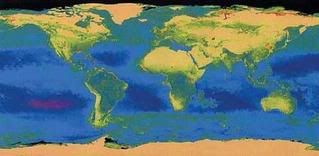
The Sahara, the Gobi, the Chihuahuan--all are great deserts. But what about the South Pacific's subtropical gyre? This "biological desert" within a swirling expanse of nutrient-starved saltwater is the largest, and least productive, ecosystem of the South Pacific. Together with the subtropical gyres in other oceans, biological deserts cover 40% of Earth's surface. But their relative obscurity may be about to change. Researchers are reporting that the ocean's biological deserts have been expanding, and they are growing much faster than global warming models predict.The Bush Era will also mark of the death of the oceans, the destruction of the environment, the speeding up of Global Warming, the spread of theocracy wars, the spike in terrorism, Peak Oil, and the collapse of world economies.The evidence comes from the Sea-viewing Wide Field-of-view Sensor (SeaWiFS) onboard the orbiting SeaStar spacecraft. Launched in 1997, SeaWiFS maps ocean color around the globe. The green of the photosynthetic pigment chlorophyll a is a measure of the abundance of plant life, which supports the base of the food chain. In an upcoming Geophysical Research Letters paper, biological oceanographer Jeffrey Polovina of the U.S. National Marine Fisheries Service in Honolulu, Hawaii, and his colleagues describe how they charted the changing size of the central region of faintest green in the subtropical gyres of the North and South Pacific, North and South Atlantic, and South Indian oceans from SeaWiFS's launch through 2006.
All of the biological deserts had grown, except the South Indian Ocean's. The total expansion was 6.6 million square kilometers or 15%, and it happened as the shallow waters of the gyres were warming. "We're seeing this pattern in each of the four ocean basins," says Polovina. That suggests to him that global warming could be the ultimate cause of the observed desert expansion.
Gyre waters are already strongly layered, so stirring by the wind brings little of the nutrients stored in deep waters to the surface to fuel plant and ultimately animal growth. Warming further strengthens this stratification, making such nourishing mixing all the more difficult. Climate-ecosystem models predict that global warming will exacerbate ocean desert expansion, but not this quickly, Polovina notes. During the past 9 years, gyre deserts expanded 10 to 25 times faster than modeled.
Did I forget anything?
No comments:
Post a Comment